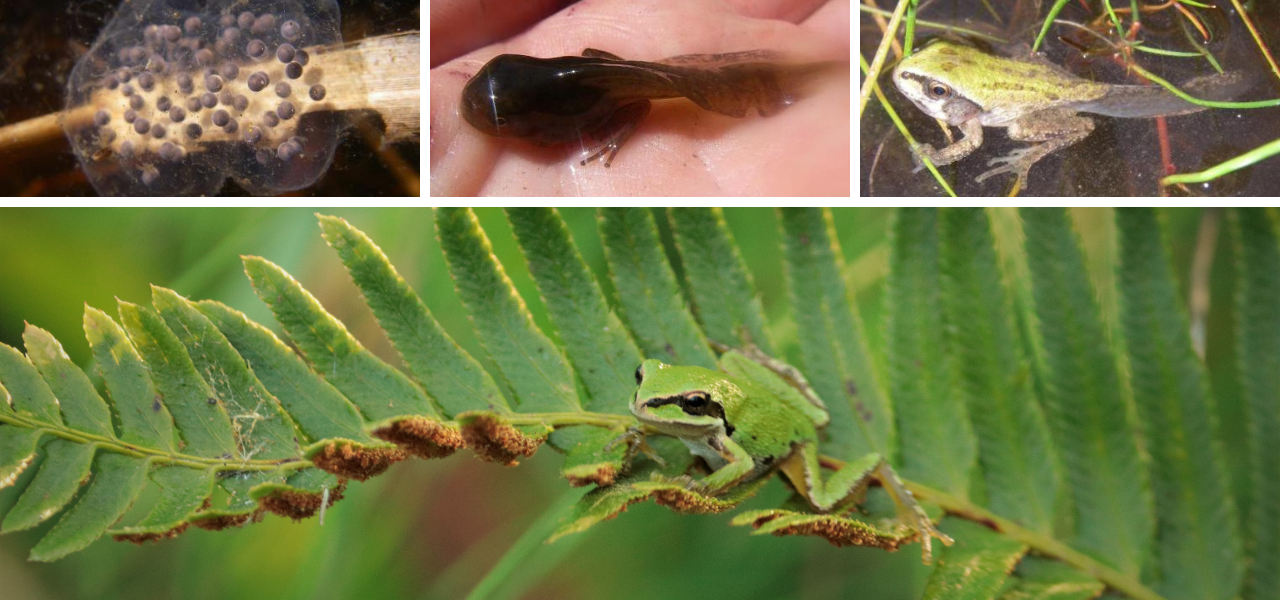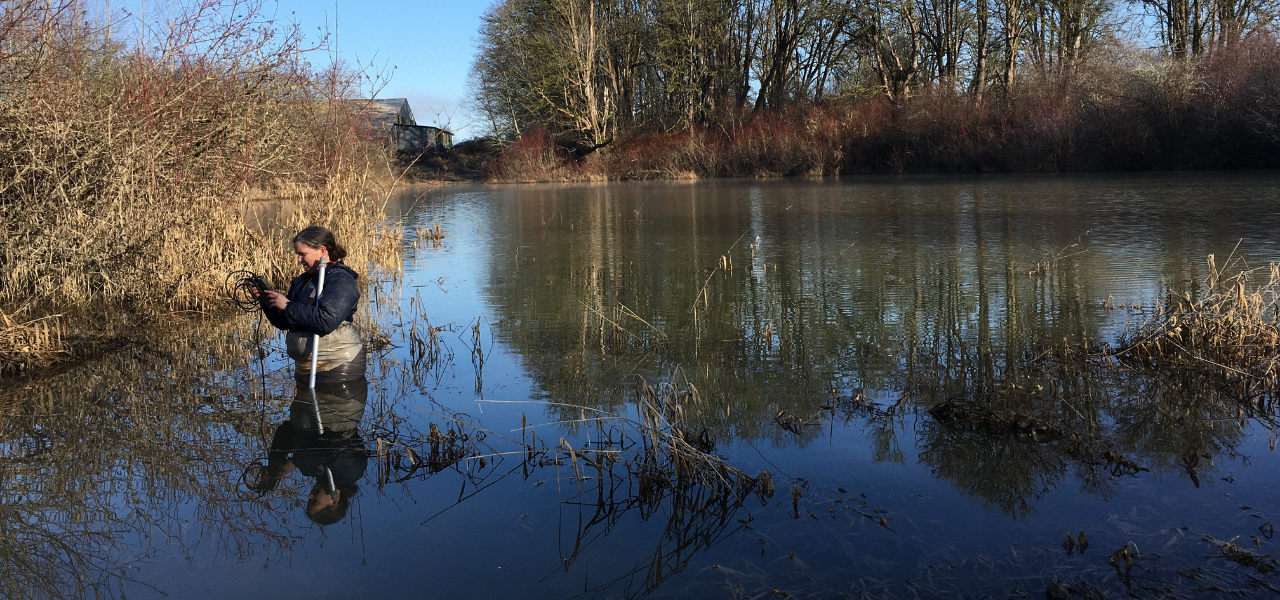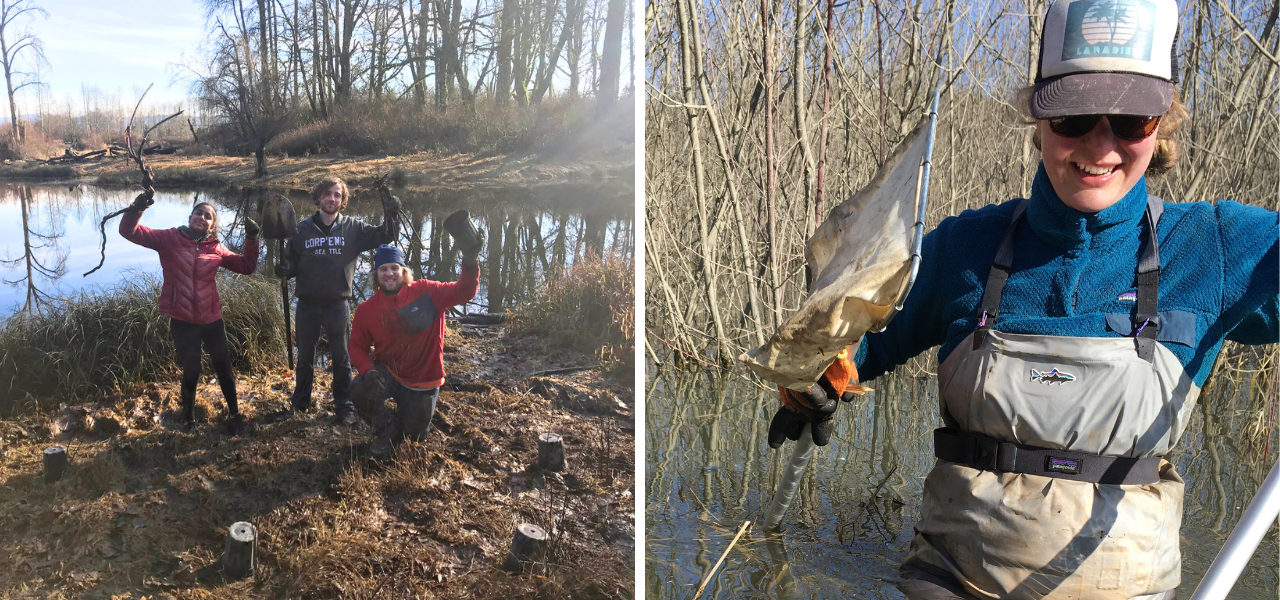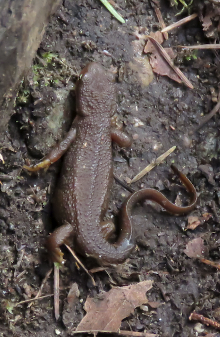Frogs Need a Leg Up
By Oxbow Conservation Program Manager, Matt Distler, PhD
On one of the first evenings in late February when the air begins to feel mild and almost spring-like, I stand in the darkening fields along the banks of the Snoqualmie River. As I silently stand on the shoulder of land above what I call the Pothole Wetlands, I hear the “crr-eek, crr-eek” of Pacific tree frogs filling the night air with their annual evening song, and I am struck with a sense of fullness and awe by their sound. Listening to this resonant and ethereal chorus, often used as a backdrop to nighttime in movies, I allow myself to feel hope for their future and for ours.
These amazing creatures are just one of 25 types of amphibians – which include frogs, toads, salamanders, and newts – that live in Washington. What makes the Pacific tree frog and other amphibians fascinating is that, as their name indicates, they lead dual lives. They begin life, emerging as tadpoles from gelatinous masses of eggs anchored to the stems of aquatic plants in ponds and wetlands, and, after 2-3 months in the pond, re-tool their bodies to spend most of their adult life on land, in meadows or moist streamside forests, returning to their watery habitats to lay their eggs. As Katie Remine, one of my conservation partners who is the Science and Conservation Education Supervisor at the Woodland Park Zoo, rightly states, “it’s kind of nuts.”

We need amphibians, and they need us.
Amphibians play an essential role in our ecosystem – their health and survival are closely linked to the health of our planet. They play a critical role in our food web, because as both predators and prey, they control insect populations by feeding on the midges and mosquitoes which would otherwise flourish uninhibited, and they serve as an important food source for birds and animals. Given their sensitivity to changes in their environment, they also serve as important indicators of our environmental health and changing climate. Declines in amphibian populations can be a warning sign of environmental problems, such as pollution, which could impact humans in the future.
And indeed, there is reason to worry about these small and sensitive travelers. They are the most threatened group of vertebrates globally, with 14 of them identified as Species of Greatest Conservation Need in Washington alone. Climate change, urbanization, invasive species, and disease are the main causes of their decline. They face a myriad of challenges, from loss and fragmentation of their wetlands and forests due to development, to their ponds drying out given rising temperatures, to battling infection from the invasive Chytrid fungus, to disappearing into the gullet of the invasive American bullfrog.
Despite the current crisis, my work as lead conservationist for Oxbow Farm & Conservation Center gives me hope for amphibians and for our future. Over the seven years I’ve worked at Oxbow, I have witnessed people stepping up to become community stewards, and, in the process, offering amphibians a leg up. This is exemplified by the story of the Pothole Wetlands where I stood in February at dusk, just a few years ago. For many years, the entire site was overrun with invasive reed canarygrass, a tall, aggressive grass with a penchant for moist soils. Thanks to the help of another non-profit, Stewardship Partners, and many local people who have volunteered their time, the reed canary grass has been removed and several shallow ponds have been dug out to create a series of small “pothole” ponds within the larger wetland. Additionally, native trees and shrubs have been planted and logs added to provide habitat for wildlife and to create a healthier streamside ecosystem for salmon in the nearby Snoqualmie River. Today, one can hear the din of Pacific tree frogs in the spring evenings and birdsong as the day breaks. The wetlands are now home to a wide variety of wildlife, including Cooper’s hawks, garter snakes, beavers and bobcats, with cameras even capturing a mother coyote teaching her pups to hunt tadpoles in the shallows.

It takes a village to ensure the survival of these creatures and community stewards play a crucial role in this effort.
Community stewards – volunteers who sign up to preserve, study, and restore the natural environment where they live – fill an important gap in Washington’s conservation initiatives, augmenting the efforts of land managers such as Oxbow and researchers with the Washington Department of Fish and Wildlife and Woodland Park Zoo. Specifically for amphibians, community stewards contribute to the cause by monitoring and surveying their populations, restoring wetlands, and creating habitats for them and other wildlife.
Two examples highlight the impact of these community stewardship volunteers on amphibians – one in monitoring and surveying and the other in restoration.
In 2012, there was little known about population trends of amphibians in Washington. Recognizing that amphibians desperately needed attention, the Woodland Park Zoo joined forces with the Washington Department of Fish and Wildlife to start the Community Science Volunteer Program, calling upon community members to get involved and contribute baseline and monitoring data on local amphibians.
“We didn’t know what the interest would be, but within a week we had 70 people sign up to help in the monitoring and surveying of local amphibian populations and their wetland habitats.” states Katie Remine.
Eleven years later the program continues to flourish, with about 80 community science volunteers going out in small teams once a month from January to July to search for, observe and record the eggs, tadpoles, and adult frogs and salamanders they see across 17 wetlands in Snohomish and King Counties.
As the program has flourished, so has the volunteers’ impact. Volunteers have collectively contributed 2270 observations, identifying 16 species, since the program started. The data, which is logged into an online community-science data portal called iNaturalist and vetted by amphibian experts, helps land managers and researchers make informed decisions about habitat preservation.

At Oxbow, restoration volunteers have made a different kind of contribution. Led by staff from Oxbow and Stewardship Partners, these volunteers have been instrumental in helping to rebuild riparian forests along the edge of the Snoqualmie River. Over the last five years, they have pulled up invasive blackberry bushes, smothered reed canarygrass, and planted native trees, shrubs, and wetland plants. Following the listing of Chinook salmon and steelhead in the 1990s, many organizations were inspired and funded to carry out similar habitat restoration projects as part of the regional effort to recover Pacific salmon runs, which have famously and sadly been declining over the last century. As intended by the Endangered Species Act, restoring streams and streamside forests for salmon recovery provides multiple benefits, simultaneously improving habitat for amphibians and many other species. At Oxbow alone, volunteers have spent over 4,000 hours in the past five years doing much-needed restoration work along the Snoqualmie River, yielding far more positive change for salmon, elk, bobcats, and, yes, amphibians than Oxbow could have done on its own. Across the Snoqualmie watershed, conservation organizations, government entities, and the Snoqualmie Tribe of Indians, very often working with community volunteers, have replanted over 250 acres of critical streamside forest habitat since 2005, according to a recent report produced by the Snoqualmie Watershed Forum, which coordinates and funds salmon recovery work in the watershed.
“Many hands make light work”, states Julia Jordan, a restoration volunteer who signed up to help Oxbow during the early days of the Pandemic. She recalls a day when she could see what seemed like miles of invasive blackberry bushes and thought, “how will this ever change? She goes on to say, “but by lunchtime, we had pulled up so many bushes.”
“Being in a space with people, doing the work together, and seeing the visual impact of what we have accomplished gives me a sense of hope and a feeling that collectively we can achieve something.”
-Restoration Volunteer, Julia Jordan
By working together, volunteers have achieved far more than either Woodland Park Zoo or Oxbow could have done alone in monitoring and surveying amphibian habitats and in doing much needed restoration work.
Engaging in Community Stewardship benefits not only amphibians but also you.
When I ask volunteers about their motivations for participating in monitoring or restoration work, their responses are varied. Elaine, a retiring physician in Seattle who has volunteered since 2016 with Woodland Park Zoo’s Amphibian Monitoring Program, shares that it provides her with an opportunity to contribute data to shed light on the declining amphibian population. She experiences an adrenaline rush from monitoring and finds it rewarding that her team’s data has a greater impact when it is included in the collective findings to create broader awareness.
On the other hand, Julia joined Oxbow as a restoration volunteer to give back to the land and combat the feeling of powerlessness she often experiences in the face of climate change.

Regardless of their individual reasons for volunteering, most volunteers express a sense of joy in slowing down to observe nature and be part of a community. They appreciate the opportunity to learn by doing and take pride in knowing that their work is making a positive difference for amphibians and other wildlife. Elaine recounts a story of her team discovering a newt in the Hazel Wolf Wetlands in July 2022, which was an incredible moment for her, as she had never seen this elusive creature before. She concludes by saying, “I was overjoyed that we made this discovery together. We observed it for a while and then released it back to its natural habitat.”
These reflections from volunteers fit within a growing scientific understanding of the positive psychological benefits of connecting with nature and of environmental volunteerism, specifically. A 20-year longitudinal study in California indicates that involvement in environmental volunteerism – more than other forms of volunteerism – is associated with high levels of physical activity, better health, and reductions in depression over time.
So, the contributions of volunteers are crucial to the missions of environmental non-profits, and they improve the lives of the volunteers as well. The virtuous cycle has one last, important step, though. Through working side-by-side with conservationists and restorationists, committed volunteers often become lay experts over time, and bring their enthusiasm and newfound expertise back to their backyards, schools, neighborhood parks, and city councils.
My hope is that while we are working side by side, volunteers are inspired to take what they’ve learned home to be stewards of their environment wherever they live. As Maria, one of my colleagues at Oxbow states:
“A moment of marvel can inspire a lifelong interest.”
What Does The Future Hold?
Inspired by the positive impact of monitoring and restoration volunteers, Woodland Park Zoo has launched an initiative, led by Katie Remine, and funded through a National Fish and Wildlife Foundation grant. The initiative brings together monitoring and restoration volunteers, along with six partners including Oxbow, The Snoqualmie Indian Tribe, and Forterra’s Green Seattle Partnership, to restore over 3 acres of wetlands and monitor 15 acres of wetlands over the next few years. Typically, community science efforts and restoration volunteer programs are managed by different institutions and have little overlap. However, this initiative aims to unite them, enabling restoration volunteers to learn more about the impacts of their work and community scientists to help improve the habitats they monitor. As part of this effort, the Woodland Park Zoo Amphibian Monitoring Program will partner with the Oxbow conservation team and volunteers to further enhance and expand the once-barren Pothole Wetlands, starting in the fall of 2023. The National Fish and Wildlife Foundation grant also provides an exciting opportunity for Oxbow and Woodland Park Zoo to bring together and collaborate with other amphibian monitoring organizations across Washington, Oregon, and B.C., many of which also rely on community stewards, to share findings and amplify their impact.
Want To Get Hands-On?
If you’re intrigued by amphibians and want to get involved, you can sign up to restore habitats along the Snoqualmie River with Oxbow’s conservation team on the second Saturday of every month from 10am to 1pm or sign up to join Woodland Park Zoo’s Amphibian Monitoring Program for 2024.
If you’re unable to join in person, you can still show your support by exploring iNaturalist to discover amphibians in your local area.
And finally, please explore oxbow.org to learn more about Oxbow’s work, events, and other opportunities to engage.
